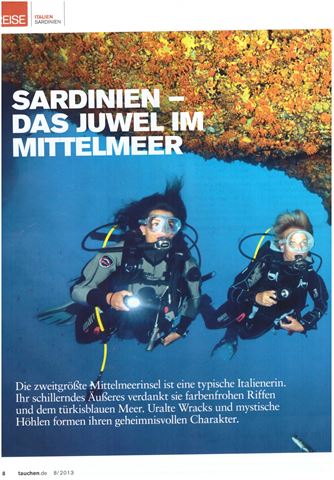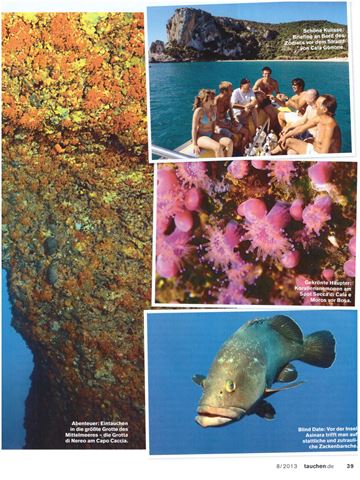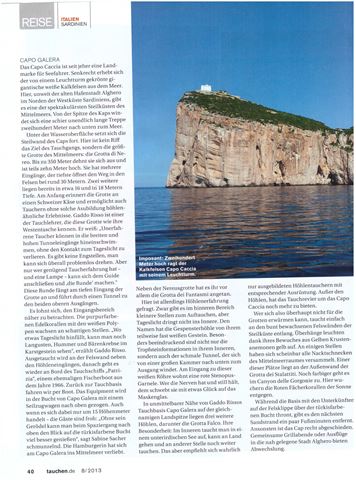The second largest Mediterranean island is a typically Italian. It owes its dazzling exterior to colorful reefs and the turquoise blue sea. Ancient wrecks and mystical caves shape its mysterious character.....

Capo Caccia has always been a land mark for seafarers. Gigantic white limestone cliffs crowned by a lighthouse rise vertically from the sea. Here, not far from the old port city of Alghero in the north of the west coast of Sardinia, there is one of the most spectacular steep coasts of the Mediterranean. From the top of the cape an almost infinite staircase winds two hundred meters down to the sea.

The steep face of the cape continues below the surface of the water. The aim of the dive is not a reef, but the largest cave in the Mediterranean: the Grotta di Nereo. It extends up to 350 meters and is sometimes ten meters high. It has several entrances, the deepest opening the way into the rock at around 30 meters. Two more are located at about 16 and 18 meters depth. At the beginning, the cave is reminiscent of a Swiss cheese and allows divers without such experience to experience cave-like experiences. Gaddo Risso is one of the diving instructors who knows this cave like the back of his hand. He says: "Inexperienced divers can swim into the wide and high tunnel entrances without losing contact with daylight. There are no bottlenecks, you can turn anywhere without any problems. But only those who have sufficient diving experience - and a lamp - can join the guide and do whole tour ". This tour begins at the deep entrance of the cave and leads through a tunnel to the two upper exits.It is worth taking a closer look at the entrance area. The purple colored corals with the white polyps grow in shady places. "Wherever there is some daylight, you can still see lobsters, lobsters and barracks in the karst rocks," explains Gaddo Risso. You dive on the rock face next to the hollow entrances, then you go back on board the diving ship Patrizia ", a former fishing boat from 1966. We return to the diving base by boat. The equipment is lifted up from the bay of Capo Galera Diving Center with a cable car even if it is only 15 meters further up - the guests are happy: "With your trolley you can enjoy the view of the turquoise bay much better while walking upwards," says Sabine Sacher with a smile,she is in love with the Mediterranean Sea, and besides the Grotta di Nereo, she is particularly fond of the Grotta dei Fantasmi.

However, cave experience is required here. There are smaller spots to emerge in the rear area, but daylight does not penetrate into the interior. The Ghost Cave got its name from its partly almost white stone. Not only the stalactite formations inside are particularly impressive, but also the narrow tunnel that winds from a large chamber down to the exit. A red stenopus shrimp lives at the entrance to this white tube. If you have the nerve and hold still, it will swim onto the mask with a little luck. In the immediate vicinity of Gaddo Risso's diving base Capo Galera on the headland of the same name, there are three other caves, including the Grotta di Falco. What makes it special: Inside you surface in an underground lake, you can go ashore and walk the cave. But this is really only recommended for trained cave divers with the appropriate equipment. Besides the caves, the diving area around Capo Caccia has even more to offer.

But if you are not at all attracted to caves, you can simply dive along the colorfully overgrown rock faces of the steep coast. Overhangs glow yellow thanks to their growth of yellow crust anemones. In some places all the nudibranchs of the Mediterranean area seem to have gathered there. One of these places is on the outer wall of the Grotta delle Stalatittiti. It is even more colorful in the Canyon delle Gorgonie. Here the purple seafans grow towards the sun.